
Magnolia is a large genus of about 210 to 340 flowering plant species in the subfamily Magnolioideae of the family Magnoliaceae. The natural range of Magnolia species is disjunct, with a main center in east and southeast Asia and a secondary center in eastern North America, Central America, the West Indies, and some species in South America.

Antidesma is a genus of tropical plant in the family Phyllanthaceae formally described by Linnaeus in 1753. It is native to tropical Africa, S + E + SE Asia, Australia, and various oceanic islands. The greatest diversity occurs in Southeast Asia.

Mallotus is a genus of the spurge family Euphorbiaceae first described as a genus in 1790. Two species are found in tropical Africa and Madagascar. All the other species are found in East Asia, the Indian Subcontinent, Southeast Asia, eastern Australia, and certain islands of the western Pacific. The genus has about 150 species of dioecious trees or shrubs.
Cnesmone is a genus of plant of the family Euphorbiaceae first described as a genus in 1826. It is native to southern China and to much of Southeast Asia.

Bridelia is a plant genus of the family Phyllanthaceae first described as a genus in 1806. It is widespread across Africa, Australia, southern Asia, and various islands of the Indian and Pacific Oceans.

Daphniphyllum is the sole genus in the flowering plant family Daphniphyllaceae and was described as a genus in 1826. The genus includes evergreen shrubs and trees mainly native to east and southeast Asia, but also found in the Indian Subcontinent and New Guinea.

Cupressus torulosa, commonly known as the Himalayan cypress or Bhutan cypress, is a species of cypress tree native to the mountainous northern regions of the Indian subcontinent, in the western Himalayas.
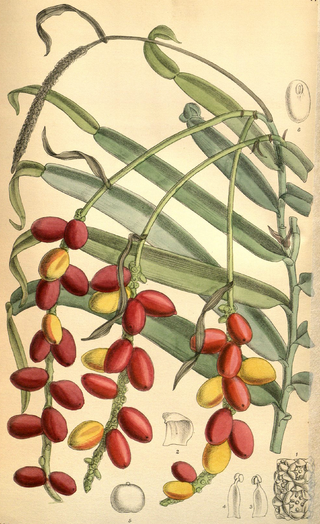
Pothos is a genus of flowering plants in the family Araceae. It is native to China, the Indian Subcontinent, Australia, New Guinea, Southeast Asia, and various islands of the Pacific and Indian Oceans.
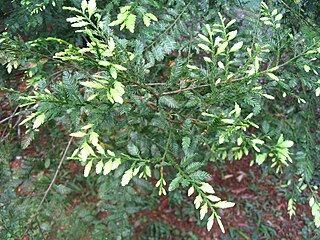
Dacrycarpus imbricatus is a species of conifer in the family Podocarpaceae. It is found in Cambodia, southern China, Fiji, Indonesia, Laos, Malaysia, Papua New Guinea, the Philippines, Thailand, Vanuatu, and Vietnam. It is a tall tree up to 40 metres (130 ft) high.

Anodendron is a genus of plant in the family Apocynaceae first described as a genus in 1844. It is native to most of tropical Asia: China, the Indian subcontinent, Southeast Asia, New Guinea, and some islands of the western Pacific.
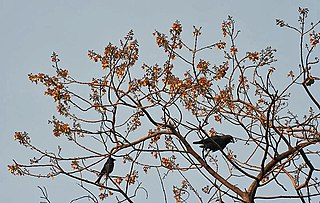
Gmelina is a genus of plants in the family Lamiaceae. It consists of about 35 species in Australia, New Guinea, New Caledonia, Southeast Asia, India and a few in Africa. Some species such as G. arborea have been planted and/or become naturalised in India, Africa and Australia. It was named by Carl Linnaeus in honour of botanist Johann Georg Gmelin.
Myriactis is a genus of flowering plants in the tribe Astereae within the family Asteraceae.
CPG Corporation is an infrastructure, building management, and consultancy services company in the Asia Pacific.

Pteroceras is a genus of flowering plants from the orchid family, Orchidaceae. It is native to China, the Indian Subcontinent, and Southeast Asia.
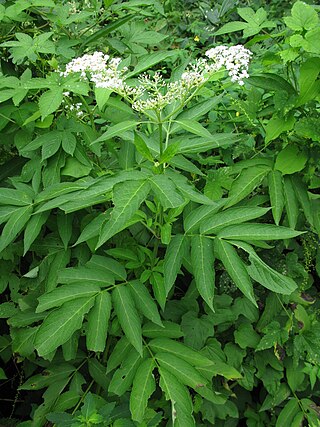
Sambucus javanica, the Chinese elder, is a species of elderberry in the family Viburnaceae native to subtropical and tropical Asia. It is found naturally in Bhutan, Burma, Cambodia, China, India, Indonesia, Japan, Laos, Malaysia, the Philippines, southern Thailand, and Vietnam. It is a perennial herb or a small shrub 1–2 m tall.

Sarsaparilla is a soft drink originally made from the vine Smilax ornata or other species of Smilax such as Smilax officinalis. In most Southeast Asian countries, it is known by the common name sarsi, and the trademarks Sarsi and Sarsae. It is similar in flavour to root beer. In the US, sarsaparilla is traditionally made with birch oil rather than the tropical plant.

Callicarpa (beautyberry) is a genus of shrubs and small trees in the family Lamiaceae. They are native to east and southeast Asia, Australia, Madagascar, southeast North America and South America.

Fraxinus griffithii, the Himalayan ash or evergreen ash is a species of flowering tree. The natural habitat includes the Philippines, Indonesia, Vietnam, Myanmar, Taiwan, China, Bangladesh and India. This plant is commonly grown as an ornamental in Australia, where it is an invasive species.
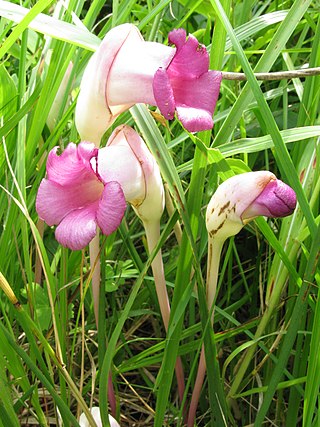
Aeginetia is a genus of plants in the broomrape family Orobanchaceae, native mostly to tropical Asia and also Cameroon.
Zippelia begoniifolia is the only species of the monotypic genus Zippelia, a genus of plants in the Piperaceae, the same botanical family as that of black pepper. The species has also been spelled as Z. begoniaefolia. It is an erect, ascending, perennial herb with leaves of 6 to 12.5 cm in length. It occurs in Borneo, Cambodia, southern-central and southeast mainland China as well as Hainan, Java, Laos, Peninsular Malaysia, the Philippines, Sumatra, Thailand and Vietnam.















